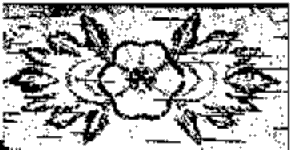
|
Birch bark bitten patterns, also called dental pictographs, are made by Native American women and children of the Great Lakes and northern New England regions. Made from the carefully pealed layers of the inner bark of the Betula papyrifera, or paper birch, the sheets are folded into quarters or eights. The folded sheet is bitten, or indented, using the eye and side teeth using fingers to help guide the placement of the pattern. When the paper is unfolded and held up to the light the translucent paper becomes transparent and luminous where the symmetrical bite marks appear. |
